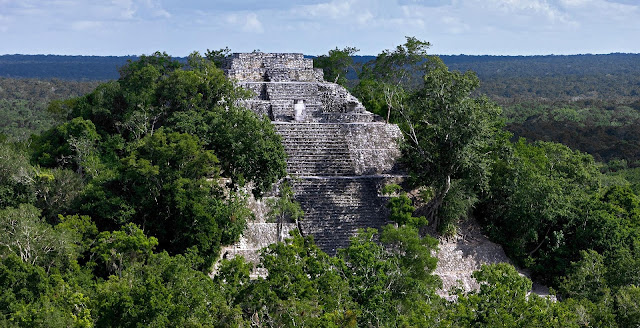The Mayan enigma
 |
| An aerial view of Calakmul in Campeche, Mexico. Courtesy Embassy of Mexico in Jamaica |
“There are seldom things that words cannot describe, and the Mayan relics in Mexico are among those chapters of history that have withstood the test of time and still, I am sure, have people in awe as they did thousands of years ago,” said Ernesto Malda, deputy head of mission, Embassy of Mexico in Jamaica.
We are sure that the people of Mexico – proud of their culture and heritage – concur with Malda’s words. The Mayan artefacts, particularly, encased in a time warp, would leave visitors mesmerised, only that the megapixel cameras of the smart phones have become the preferred tools of ‘capturing’ these pieces of human civilisation.
 |
| Courtesy Embassy of Mexico in Jamaica |
There are 35 World Heritage Sites in Mexico including 27 cultural sites, 6 natural sites and 2 mixed sites. The country ranks first in the Americas and seventh worldwide by number of Heritage sites, thanks in large part to its rich history and well-preserved archaeological sites, some of which are still being discovered and excavated.
Among the sites recognised by UNESCO are those of the indigenous populations that inhabited the land in ancient times, including the Maya civilisation.
 |
| A panoramic view of The Ancient Maya City and Protected Tropical Forests of Calakmul, Campeche, which is inscribed on the UNESCO list of World Heritage Sites. Courtesy Embassy of Mexico in Jamaica |
SOPHISTICATED CULTURE
Historians say that the Mayans developed one of the most sophisticated cultures in the Americas and in the ancient world in general, before the arrival and colonisation of North and South America by Europeans.
Calakmul, which in Mayan means “adjacent knolls”, is a pre-Hispanic urban centre located south-east of Campeche.
The Ancient Maya City and Protected Tropical Forests of Calakmul, Campeche, is inscribed on the UNESCO list of World Heritage Sites. “It (Calakmul) is one of the most important cities in the Mayan civilisation, which is also recognised by people living in this region due to its place and significance in history,” Malda said.
 |
| Courtesy Embassy of Mexico in Jamaica |
According to historical research, due to its dense population, the city had more than six thousand structures in a space of approximately 44 square miles. It was one of the most influential kingdoms in Mesoamerica (600-900 A.D.), proof of which is its extension and the splendour of its constructions.
“Calakmul is nestled in the biosphere reserve of the same name, which when joined with nearby reserves, becomes the largest tropical ecological reserve in Mexico and the second largest green lung in the continent, with an extension of over 700,000 hectares,” Malda said.
Apart from it splendid architecture, Calakmul supports a robust eco system – it is home to more than 86 mammals, around 282 birds, 50 reptiles, 400 butterfly species, and 73 kinds of native orchids.
 |
| Courtesy Embassy of Mexico in Jamaica |
Though, for most of the world, Mayan culture is encased in the celluloid representations led by adventure seekers, bounty hunters, conspiracy theories, and extra-terrestrial occurrences – the contributions of the Maya modern civilisation go beyond those fictional accounts.
CHOCOLATE
According to historians, the first culture to discover the various uses and preparation of kakawa – were the Maya. After harvesting it, they knew how to ferment it and cook it. Later, they prepared it into a paste and added water, peppers, and corn, resulting in a delicious beverage that with the passage of time and various modifications, became known as chocolate.
 |
| A delicious cup of hot chocolate - according to historians Mayans were one of the first culture to discover the various uses of chocolate. Courtesy Embassy of Mexico in Jamaica |
“The use of cocoa beans to make chocolate tea is very similar to the Jamaican tradition of grating chocolate balls and boiling them in hot water for the same purpose,” Malda said. “Cacao beans were so valued by the Maya that evidence suggests they were also given as gifts on ceremonial occasions and used as currency.”
MAYA CALENDAR SYSTEM
One of the most singular contributions of this ancient civilisation is the Mayan calendar. The Maya conducted complex and precise calculations of time and developed a cyclical concept of time. For measuring and recording the passage of time, the ancient Maya devised different units of measure. The most frequently used were:
- Kin = 1 day
- Uinal = 20 kines, or 20 days
- Tun = 18 urinales, or 360 days
- Katun = 20 tunes, or 7,200 days
- Baktun = 20 katunes, or 144,000 days
Using their knowledge of astronomy and mathematics, the ancient Maya developed one of the most accurate calendar systems in human history. Among the various calendar systems that were produced by the Maya, four stand out for the importance of their use in everyday life:
- The tzolkin, or 260-day cycle. This was a sacred calendar used for rituals.
- The haab, or 365-day cycle (which approximates the solar year.)
- The long count or “count of tome”, also known as “tziikhaab”.
- The lunar series.
 |
| Courtesy Embassy of Mexico in Jamaica |
“It is a wonderful, engaging, learning, and enriching experience. One should visit the Mayan sites and experience first hand the glory of human achievements and also get educated to a critical part of history, which has made some key tangible and intangible contributions to the modern times,” Malda said.
It is a walk back in time, rediscovering the roots and evolution of mankind’s achievements – and it could not have been better, coming with a liberal dose of chocolate.



Comments
Post a Comment